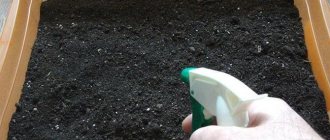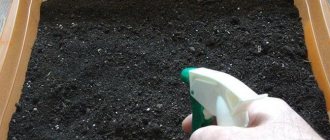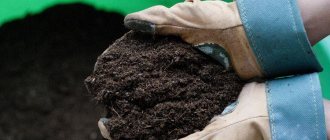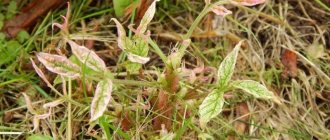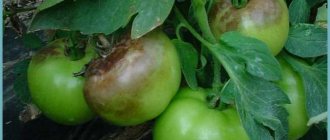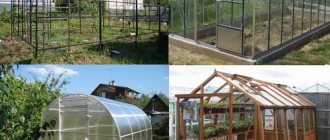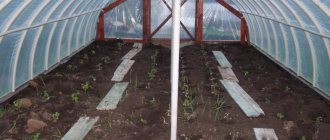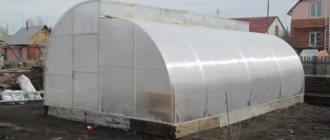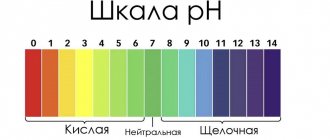Late blight is an insidious disease often found on tomatoes. In favorable years, the disease develops at lightning speed, capturing more and more new plantings of garden crops. Stopping the progress of late blight is not easy. The disease is easier to prevent by treating the soil before planting. Such treatments will protect not only tomatoes, but also other crops of the Solanaceae family.
Tillage in spring before planting and in autumn
- Spring tillage of soil against late blight is pre-planting, the main task of which is to destroy the dormant mycelium of the fungus - the causative agent of the disease. Processing times depend on the chosen method.
- Autumn tillage is carried out in case of infection of crops and to prepare the soil for winter. The soil on the site is cleared of plant debris and dug up to a depth of 30 cm with a layer turnover. In this case, the upper part of the soil turns down and is “embedded” into the ground. This way, most of the spores will end up on the soil surface.
Today, there are several methods to combat late blight in the soil. The choice of method depends on:
- intended purpose (for prevention or control);
- the extent of development and spread of the disease;
- personal preferences (some gardeners are categorically against chemistry, although in some cases its use is justified).
Know what late blight is
A disease that destroys the entire plant, including tubers, is called late blight. Sources of infection are spores. They develop on the above-ground parts of plants. They overwinter in the ground, on unharvested tops and tubers of diseased plants.
Infection occurs through the air and through the ground. Peppers, potatoes, eggplants, physalis, tomatoes and other nightshade crops suffer from this disease. Active reproduction begins in a humid and warm environment (from +10 °C).
In the initial stage, the disease cannot be noticed. Over time, dark gray, brownish spots appear on the back of the leaves, spreading to the stem. Then the sore spots are covered with a velvety coating consisting of ripening spores. As a result, the plant dies.
Late blight rot appears as brown and dark gray spots, first on the leaves and stems, then spreads to the fruits - the plant dies
Agrotechnical methods
These techniques will help reduce the likelihood of illness or avoid it altogether:
- Autumn and pre-sowing plowing . The vegetable garden is divided into ridges of 1.5-2 meters and plowed with a spade with the top layer of soil turned downwards. This is especially true in gardens with dense plantings, where it is humid and warm. In such conditions, the mycelium of the fungus develops faster. When digging the soil, all infected tops, tubers, and roots are destroyed.
- Crop rotation . Plants of the same family have the same diseases. By alternating crops, you can get rid of many diseases, including late blight. Tomatoes are planted in the garden after any Solanaceae at least 3-5 years later. During this period, the pathogen dies in the soil.
- Tilling the soil with boiling water in the fall . After harvesting, the soil is watered with boiling water. Oomycete spores die when exposed to high temperatures. This option is effective, but labor-intensive over large areas.
Why is it dangerous?
The harmfulness of this disease lies in the fact that, despite the long period of ripening of the pathogen, it is able to infect the entire crop, for example tomatoes, in a matter of days. Gray spots appear on vegetables, around which there is a white coating .
Hence the second name of the disease – “gray rot”. The plants rot, and the fruits, accordingly, lose their marketable appearance and deteriorate during transportation or storage.
The fungal pathogen is resilient and does not die even from winter cold. Phytophthora also causes loss of crop quality, infects seed materials, and affects plant resistance to other diseases.
Folk remedies
These methods are very popular among gardeners because of their accessibility and harmlessness. True, you will have to wait a long time for the effect and the result may be dubious. Folk remedies are good for preventive purposes and will not harm crops:
- Garlic . A unique garden crop known for its bactericidal properties. Fights late blight, slugs, aphids, caterpillars and ants. An infusion of garlic bulbs is used to cultivate the soil before sowing seeds and soil for seedlings. Throughout the season, tomatoes are watered (no more than once every 2 weeks) to prevent disease and for treatment.
- Tillage of soil with dairy products under plants during the growing season.
The most commonly used are kefir or skim milk (whey). It is necessary to generously spray the soil under the plants and the plants themselves. Once in the soil, lactic acid bacteria create a microflora that is impenetrable to fungal spores. The disadvantage of this method is its fragility. After the first rain or watering, the treatment will have to be carried out again. Acceptable frequency of treatments: 1 time in 10 days. - Iodine and brilliant green. Popular broad-spectrum antiseptics. A few drops of antiseptic are dissolved in milk and the soil is treated before sowing, planting and during the growing season. This tool has a number of advantages:
- mineral nutrition for tomatoes;
- stopping the development of late blight or preventing it;
- protecting your garden from slugs.
- Infusion of rotted straw . The soil for tomatoes is watered before planting seedlings and after harvesting. The effect of the treatment is questionable and is more reminiscent of organic fertilizer.
- Wood ash . In the spring, sifted and dry ash is scattered on the soil and dug up. Afterwards, the tomatoes are watered generously. With frequent use, the acidity of the soil increases greatly. To regulate its acidity during autumn digging of the site, it is necessary to lim the soil by adding dolomite flour.
All folk methods are good because they are simultaneously a measure to combat late blight and organic plant nutrition. They can be used individually, or prepare a complex solution of several products.
What crops does it affect?
First of all, the disease late blight affects the nightshade family , which causes significant harm to gardeners. As already mentioned, this disease is extremely terrible:
- for nightshades, affects peppers, tomatoes, eggplants, potatoes;
- cucumbers, zucchini, squash;
- citrus fruits;
- strawberries, strawberries;
- grapes, currants;
- buckwheat;
- castor bean and other plants.
Biological drugs
Unlike folk remedies, they have a visible effect in the early stages of late blight.
Their action is based on the influence of waste products of bacteria, fungi or microorganisms that make up the drug. The drugs are harmless to humans. They are used both as a preventive measure and to get rid of late blight in the soil. The following drugs are most effective :
- Baktofit and Trichodermin.
- Fitosporin -M.
- Planzir and Alirin B.
- Baikal EM (1; 5).
Mulching
This is one of the main conditions for a successful struggle. I mulch the beds to block the path of spores from the ground to the leaves. Of course, late blight spores will inevitably fly to you from your neighbors, but there will be much fewer of them than there are in your land. It is only important that the earth first warms up completely.
I used mown grass, covering material, and sawdust as mulching materials. Now I've settled on sawdust. We have loam, and sawdust after digging makes the soil looser.
How to disinfect soil with chemicals?
They are the most effective and fastest-acting method of protection. Many products are highly toxic and, if used incorrectly, can be dangerous to animals and humans. Hazard class 3 drugs are allowed for use on private farms. Chemicals are used at an advanced stage of the disease , or when it is very widespread.
When deciding how to treat the soil in spring or autumn, how to disinfect it, and ultimately cure it, you should pay attention to the following drugs:
- Quadris.
- Oksikhom.
- Copper sulfate.
- Copper oxide.
- Farmayod.
Phytophthora is able to quickly adapt to pesticides. Use a different type of drug for re-treatment.
Causes of late blight
Late blight is transmitted from a diseased plant to a healthy one through direct contact, through the soil and by wind. Harmful spores are spread throughout the entire area, “traveling” on the soles of the gardener. Don't forget about pets and insects. They can also become carriers of infection.
The pathogen is capable of living in the soil cover for several years. In this case, its activation will occur when suitable conditions occur. You can get rid of the disease using chemicals and traditional methods.
Green manure against disease
This is a special group of plants grown to improve the structure of the soil, enrich it with nitrogen, inhibit the growth of weeds and combat late blight. Another name for green manure is green manure. To successfully combat late blight, the following sowing scheme is recommended:
- The first sowing is carried out immediately after harvesting.
- The second sowing is from mid-October until the first frost. In the spring, the seedlings will destroy the infection.
- For the third time, green manure is reseeded in the inter-row spaces of cultivated plants.
The main principle of action of green manure is that it releases substances that are destructive to fungal spores and inhibits the growth of weeds that carry the disease. The main green manures in the fight against late blight are :
- Mustard – white or yellow. It has the highest phytosanitary properties in comparison with other green manures.
- Phacelia.
- Oilseed radish or rapeseed.
To achieve the best result, it is recommended to sow all crops together - with a mixture of seeds.
Planting green fertilizer during the onset of infection will not give an effect, since they need to develop leaf mass (this will take 1.5-2 months).
Take measures against late blight
The problem with late blight does not go away on its own. Without our intervention, an epidemic begins. Fungal spores are tenacious, do not die in the cold and will last for 7 years. With the onset of spring, they begin to develop and lead to repeated destruction of the crop.
The earth is infected with late blight, what should I do? You can defeat the disease in your area by creating unbearable conditions for the development of the disease. The main steps are to disinfect the ground. You can cure the infected area in different ways:
- plant green manure;
- fumigate greenhouses with sulfur bombs;
- spill the soil with bactericidal solutions.
Inaction is unacceptable. Particular attention should be paid to infected tops and tubers, as this is a source of infection. They must be taken away from the territory, or doused with kerosene and burned.
Rotten tubers and collected tops must be immediately removed from the site or burned, otherwise the pathogen will develop further when it gets warmer
Do not bury diseased stems - this is a breeding ground for pathogenic organisms. Once opened, the infection will spread through the air and the problem will remain.
Features of soil treatment in a greenhouse
High humidity in greenhouses and greenhouses in the absence of regular ventilation often causes the appearance and spread of the disease. Since late blight is a common occurrence in a greenhouse, it is recommended to change the soil annually, but such a measure is not always available. Among the agrotechnical techniques available:
- hot disinfection (2-4 weeks before planting seedlings, the soil should be watered with boiling water and covered with a film for deep steaming);
- acidification of alkaline soils by adding peat (phytophthora loves an alkaline reaction).
Therefore, regular application of disinfectants is sometimes the only option to combat late blight in the soil. The most effective in greenhouse conditions are biological and chemical means of protection :
- Trichodermin or Fitosporin for pre-planting soil treatment (the dry biological product is scattered on the surface of the ground three times: when digging for planting tomatoes, the second and third time - after 30 days).
- Copper-containing preparations - HOM, copper sulfate or Bordeaux mixture (their solution is spilled on the soil and frame elements of the greenhouse in spring or late autumn).
- Fungicide Ridomil Gold (the first treatment is carried out before the development of the disease, 1-2 weeks after planting the seedlings. The second – at the peak of a high risk of late blight or when the first signs of the disease are detected. It is important to complete the final treatment before the end of tomato flowering).
It is better not to close the greenhouse for the winter . Under the influence of low temperatures in the soil, most pathogens will die.
Protection
To protect the crop from negative parasitic microorganisms in the garden or garden, plants should be treated with chemicals.
In fact, there are a huge number of similar substances, but the infection easily adapts to them, so it is recommended to alternate fungicides.
During the growing season, it is better to use: 1% Bordeaux mixture, copper oxychloride suspension (2g per 5 liters of water), Ditan (1g per 5 liters). These drugs have a more gentle effect . However, systemic fungicides are more suitable for treatment, which, penetrating the plant, kill the infection from the inside, thereby completely blocking its spread throughout the plant.
Prevention
Most oomycete spores are found in the ground. In autumn and spring, the main preventive measures are digging up the soil, removing plant debris and disinfecting it. Let's consider what can be used for preventive soil disinfection. This is most often:
- a strong solution of potassium permanganate (it is a powerful antiseptic and, in combination with hot water, kills overwintering fungal spores);
- copper-containing preparations (only for early spring application during the first plowing of the land);
- biological product Fitosporin-M (the solution is prepared in water at a temperature of no more than 35 °C, so that diseased bacteria do not die. The drug is allowed to infuse for 1-2 hours).
Fungal spores reach plants with rising air currents from the heated soil. To prevent this, it is recommended to mulch the top layer of soil immediately after digging it in the spring.
Remember
- Carry out prevention . Late blight on plants develops and spreads very quickly, and can deprive the harvest, so preventive treatment of plants is carried out.
- Remove tops . If the affected plant remains are not removed from the site, the infection will continue to actively destroy the plants in the new season. Burn infected stems and fruits.
- Use biological drugs . Give preference to effective and harmless products based on the work of beneficial bacteria.
Late blight is a dangerous enemy of the garden. Use any means to fight it, and your crop will not suffer from the infection.
Advice from experienced gardeners
- Vladimir, Lipetsk region. “I use proven resistant tomato hybrids. I don’t resort to chemicals; I always sow mustard next to the tomatoes.”
- Oksana, Moscow region . “I grow tomatoes in a greenhouse and am not too lazy to change the soil. I replace the soil for planting every 2-3 years and compose it myself, always adding ash and Fitosporin-M.”
Only comprehensive measures will protect the garden from possible outbreaks of late blight. At the first symptoms of the disease, it is not advisable to completely abandon chemotherapy. Proper use of agrotechnical measures, biological protection agents, cultivation of green manure and crop rotation guarantee the health of tomatoes and other vegetable crops.
Types of late blight
Known species include:
- Phytophthora infestans Mont de Bary. It affects potatoes and other nightshades and is active between May and August;
- Phytophthora fragariae Hick. There are two forms (var. Rubi, var. Fragariae). Microorganisms of this type can destroy the harvest of raspberries, strawberries and buckwheat;
- Phytophthora cactorum Schroet. Symptoms indicating infection occur on trees from families such as rose hips and beech.
If you know how to deal with this disease, you can save your harvest from this disease.
Read the article about potato late blight.
Thermal type impact
There are tomatoes for greenhouses that are resistant to late blight, but experienced gardeners do not take risks and carry out preventive measures without relying on such information.
To implement this method, you need to create a certain temperature regime, frying or freezing. Manipulations are often carried out in the fall; it is better to choose a dry day.
To destroy the pathogenic fungus, you should tightly seal the room, close all the cracks and raise the temperature to 30 degrees; the spores will become inactive, and when raised to 35 degrees they will completely die.
To carry out freezing, you should choose a cold day; not all regions of the country can boast of such indicators, so the method is used by a limited number of gardeners.
What does it come from?
Damage to plants during late blight is caused by oomycetes, which until recently were classified as fungi, but are now classified as a separate group of special mycelial organisms. Phytophthora specializes in nightshade representatives, so potatoes, eggplants, tomatoes, peppers and physalis become their victims in garden beds.
Oomycetes spend most of their life cycle in the spore phase, located in the soil and the remains of diseased plants. Only with the onset of favorable conditions do they begin active life activities, the purpose of which is to leave offspring. When the air is heated to a temperature of +25 - +30 ° C, spores in dew drops can germinate and infect the plant within an hour.
Late blight is especially active during sudden changes in daily temperature, when the heat of the day gives way to rather cool nights, which contributes to frequent fogs and heavy dew. Frequent rains in late July and early August also contribute to its spread. But dry weather, as well as heat above +30 °C or cold weather down to +10 °C and below, lead to an almost complete freeze of the pest’s vital processes.
Late blight affects almost all parts of plants: gray-brown spots appear on leaves, fruits or stems. At the same time, in rainy weather, diseased plants rot, and in dry weather, they dry out and break. Spores from them are washed into the ground, and are also actively spread around by drops of water and gusts of wind.
Penetrating quite deeply into the soil, late blight spores successfully survive winter frosts and again begin to attack nightshade crops in the summer. They can also overwinter quite safely in the remains of infected plants abandoned in the garden.
